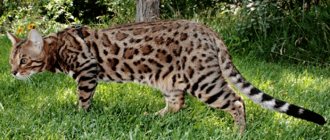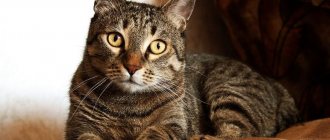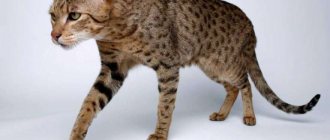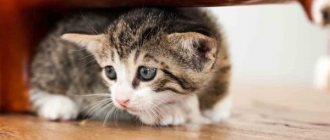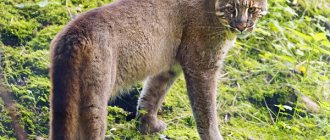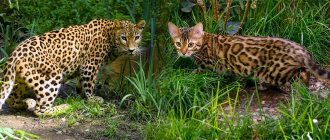One of the rarest representatives of the cat family is an animal called the clouded leopard. Let's take a look at the photo of the clouded leopard and admire this truly majestic predator.
The clouded leopard's habitat is tropical dry forests. This species is considered endangered, so predators are protected by law in most of its range. But in Thailand and India, few people follow these laws.
Clouded leopard (Neofelis nebulosa).
Today there are about 250 clouded leopards in zoos, and there are about 10,000 in the wild.
Clouded leopard video
In the qualifying generic list, the animal does not belong to any genus. As a species with similar features, it was included in the same genus with the marbled feline and the tiger. The clouded leopard is a kind of “transition” from the impressive size of predators and smaller cats living in nature. And more recently, this amazing cat is classified in the same genus as the tiger.
The jungle is the home of the clouded leopard, which stretches from lowlands to mountain passes. The maximum point where the predator was encountered was 2.5 kilometers above sea level. It has even been seen in the Tibetan mountain ranges. Being an excellent tree climber, the clouded leopard actually does not leave the upper tiers of the jungle. They serve him not only as a place to sleep and rest, but also as an ambush in which the animal awaits its prey.
This animal is very difficult to see. He lives in places that are practically inaccessible to humans. The color of the “fur coat” allows the predator to become almost invisible in the lush greenery of the jungle. The clouded leopard is an agile predator capable of moving along branches in the upper tiers of the jungle. The danger that awaits the cat is the intensive destruction of the forests of China and southeast Asia, the animal’s natural habitat.
Natural habitat
In the wild, the distribution range of leopards is wider than that of all other members of the cat family. The teaching explains this phenomenon by the fact that leopards lead a secretive lifestyle, are able to camouflage themselves well, and can hunt almost any living creature.
The wild leopard's habitat is extensive
Spotted predators inhabit almost the entire territory of Africa (they are not found only in the Sahara Desert), live in the northeastern and central regions of Asia, and are found even among the snow-capped mountains of the North Caucasus.
What does a clouded leopard eat?
The clouded leopard is a carnivore whose diet consists of jungle primates and birds. The cat catches and kills its prey only with a powerful blow of its paw, being high above the ground, in the branches of trees. Natural camouflage allows the predator to sneak up close to the prey, remaining unnoticed against the background of foliage.
The clouded leopard hunts not only in trees. On land, goats, pigs and deer can be its victims. No matter how heavy the prey, the predator easily and without fear of falling jumps onto a tree and only there begins to eat. With game in its mouth, the clouded leopard is able to maintain its balance while standing on its two hind legs.
Very often, deforestation forces the predator to attack livestock. Although he usually tries to avoid places inhabited by people. Not only the clouded leopard inhabits the expanses of the jungle, tigers and panthers, which are stronger and larger, also live there. Therefore, in the event of a collision, the clouded leopard prefers to leave, since it knows that it will lose. For a very long time it was thought that the predator was exclusively nocturnal, but now the inconsistency of the bottom statement has been reliably documented. He hunts not only at sunset, when his potential prey is sleeping, but also during the day.
№11
They can go without water for quite a long time. However, this does not mean that they do not need water at all. When it comes to surviving in hot climates, the leopard can survive without water sources due to the fact that it draws water from its meat. Also, these wild cats may eat grass or other plants in order to replenish their body's water reserves.
We also recommend reading: Interesting facts about the black panther
Clouded leopard cubs
Due to the fact that the clouded leopard lives in hard-to-reach places, there is very little information about its mating games and reproduction. It is known that in zoos the birth of kittens occurs in the spring months. Usually a female gives birth to 2 blind kittens, but sometimes there are 5 babies in a litter. The weight of the kittens is negligible, only 150 grams, they are blind and practically motionless. They begin to see after two weeks, and on the 35th day of life they actively move around the den. For 70 days, the mother feeds the clouded leopard kittens only milk, without adding meat to the babies’ diet.
At the age of five months, kittens begin to slowly eat meat that the mother brings from the hunt. Grown-up babies gain complete independence only at the age of nine months, but before this time they must learn the hunting craft and adopt all the skills from their mother when she takes them hunting with her. Games play an important role, in which clouded leopard kittens spend most of their time. They help not only to fully develop and build much-needed muscle mass, but also provide initial hunting skills. The fur of kittens is monochromatic until they are six months old, and only with age do they develop characteristic patterns, like those of adults.
№7
Very often people confuse leopards and cheetahs. In fact, they have significant differences. Firstly, cheetahs are slimmer. Secondly, cheetahs have characteristic black markings from the corner of their eyes to their mouths. Leopards do not have such markings. Third, a leopard's spots are clusters of markings, often forming circles, while a cheetah's are simply black dots.
Clouded leopard and people
The man began to sound the alarm when the clouded leopard was on the verge of extinction. Having no prohibitions, in the last century, people did not hesitate to exterminate the animal, solely because of its elegant skin. Poachers still trade, despising the laws, with hats made from the fur of a predator.
People noticed the likelihood of extinction of the species when they came to its sought-after lands for valuable wood raw materials. Almost the entire habitat was destroyed, including the most inaccessible corners. The clouded leopard never inspired fear among the aborigines, like the tiger, but this did not stop it from being destroyed, since occasionally poultry fell into its paws.
№3
They are carnivores, but they are not too picky when it comes to food. They hunt any animal that comes into their field of vision. In addition to gazelles and antelopes, they also hunt rodents, monkeys, snakes, large birds, amphibians, warthogs and porcupines. They also often fish in the water.
They eat approximately 1400-1800 kg of food per year.
Where does the clouded leopard live?
The lands of India and Nepal, to the east, passing the Himalaya mountain range to the southern regions of China, the eastern territories of Asia, spreading to the south, on the islands of Sumatra, Java and Kalimantan, including the impenetrable corners of Taiwan, lives an amazing and elusive predator.
Clouded leopard conservation
The clouded leopard has practically disappeared as a species and, of course, is now under international protection, including the Washington Convention (CITES).
Appearance
The predator has an elongated body. It is very flexible, like all cats. The coat is thick and short. Although the legs are not long, the presence of hard calluses on the paws allows them to climb trees excellently. The animal is distinguished by a large massive tail with fur. It takes up half the length of his body. However, the Taiwanese clouded leopard has a much shorter tail.
The animal's skull is elongated. This sets him apart from other cats. The eyes are yellow-brown in color. The fangs are large. This is especially noticeable when the animal yawns or growls. This is associated with adaptation in the natural environment. The predator is forced to catch prey by climbing trees. In order to keep it suspended, longer teeth are needed. In addition, with the help of large fangs, the victim can be killed with one bite. The structure of the fangs makes it look like a prehistoric saber-toothed cat. The length of the upper fangs can be more than four centimeters.
Thanks to the structure of the jaw, these animals can roar, albeit very softly, and also purr. However, you should not even try to start them at home. They won't become murky.
Animal protection
Due to the demand for animal skins, teeth, and bones, the population of these predators is sharply declining. Reducing the habitat also leads to irreversible consequences. The Taiwanese subspecies is considered extinct, and the remaining ones are on the verge of extinction.
By law, catching these cats is discouraged in the following regions:
- Myanmar;
- Taiwan;
- Vietnam;
- Bangladesh;
- India;
- China.
The United States has passed a law according to which the clouded leopard is classified as a rare species, therefore trade in its skins and other organs is prohibited in the United States.
The demand for beautiful fur gives rise to poaching. Hunters illegally capture and kill animals for the purpose of enrichment.
In addition, many farmers are unhappy with the unsafe proximity to smoky cats. Predators coming to the village are capable of destroying most of the population of pigs, goats and other living creatures. Therefore, farmers are waging an underground struggle against unpleasant neighbors. They use traps, baiting with dogs, poison and other illegal methods.
In 1975, the Convention on International Trade in Wildlife (CITES) decided to ban the sale of this subspecies of leopards in any form or even partially.
Content Features
A clouded leopard as a pet is very rare. An active animal requires a spacious enclosure, well equipped and occupying a fairly large area. Reproduction in captivity occurs very rarely.
Smoky individuals are purchased from specialized nurseries that breed predators in captivity. The price for a cute wild cat starts at $25 thousand. In addition, it will take an impressive amount of money to feed her pussy every day, because she will not eat anything other than meat and fish dishes.
The purchase of a clouded leopard pays off only if it is placed in a zoo, where the price of a ticket and the huge number of visitors make it possible to provide the wild predator with everything it needs.
Description
The clouded leopard is neither a large nor a small cat - it occupies an intermediate position, combining the signs and characteristics of both. And in terms of size, it can be called more of an average cat.
The length of the animal (excluding the tail) is approximately from 85 to 105 centimeters. The height at the withers reaches half a meter. The fluffy tail is almost the entire length of the body and can reach 90-95 centimeters. The predator's pride is covered with fur, forming a tassel at the end and decorated with black rings.
A leopard weighs about 20 kilograms; some larger individuals living in places where there are no food problems gain 5-10 kilograms more.
Clouded leopards, like a considerable number of mammals, have sexual dimorphism - the male is always larger than the female.
A distinctive feature of the clouded leopard is the special structure of its teeth; the fangs protrude forward by almost 4 centimeters. For such a small animal, these are quite large teeth, which is why the clouded leopard is often compared to a saber-toothed tiger. The head of the animal, like all cats, is elongated, yellow eyes with oval vertical pupils are also cat-like, the nose is pinkish, sometimes with black spots.
The paws for an animal of this size are quite short, the front ones are slightly shorter than the back ones. Large claws extend completely and hide deep into the limbs. When walking, a leopard touches the ground only with its toes, and not with its entire foot.
The color of a leopard can be compared to the color of a marbled cat. The color of the coat varies from sandy brown to dark gray. The entire surface of the body is strewn with black rosettes, the front part of which is lighter than the back, and the center has the same color as the host’s skin. The cheeks and forehead are decorated with black spots, the same are present on the stomach and paws.
Description
Body length 60-110 cm. Height at withers 41-45 cm, tail length 80-90 cm. Weight 11-23 kg. Males are slightly larger than females. Relatively short limbs and a long tail make it easy to move along tree branches.
Long, strong claws provide a strong and secure grip. The paws are large and wide. The animal can retract and extend its claws as needed.
The fur is short and dense, white-gray, smoky or gray-brown. There are many black small spots on the forehead, and black stripes on the cheeks. Two black stripes are located on the neck and along the ridge.
There are black circles and spots on the head, belly and tail. The lower part of the body is lighter or almost white.
The life expectancy of a clouded leopard in natural conditions does not exceed 11 years. In captivity, with good care, some individuals live up to 17 years.
Behavior
The animal leads an active lifestyle around the clock. It can hunt even during the day, but prefers the night time. The leopard swims well and moves along horizontal branches. At the same time, it can lower its head down and hang on a branch like a sloth.
The animal lives alone, except for the mating season. The area occupied by one individual can reach 45 square kilometers.
External description
The Asian predator has an unusual color. The main background of the coat can be straw-brown, up to a dark grayish tint. The fur on the face is white, with black markings located on the forehead and cheeks. The belly and short legs are decorated with oval spots of charcoal color.
In babies up to six months old, the spots on the sides are solid, differing in brightness. In older animals, the spots take on the shape of an ellipse with light hair in the center. The back group of spots is slightly different in color intensity from the front; they are darker and more expressive.
The height of the animal, measured at the withers, ranges from 50-60 cm. The total length of the body (with head, but without tail) is 75-100 cm, the tail has the same length as the whole body - up to 90 cm. Weight of adult pets averages 20 kg. Females differ slightly in size from males, that is, the severity of sexual dimorphism is not observed.
The external features of clouded leopards are as follows:
- The eyes are beautiful yellow or gray-green, vigilantly watching for prey. The pupils, like all representatives of the cat family, are vertical.
- The length of the fangs varies from 3.5 to 4.5 cm, but there are also longer specimens. If we compare the length of the fangs and head, as well as the dimensions of the body, it turns out that clouded leopards have the longest fangs.
- Nose – has a pink color, sometimes there is black spotting.
- A characteristic feature of this animal species is its short legs. The hind limbs are much longer than the front legs. The claws of this wild cat extend and are of impressive size. The leopard of this species belongs to the digitigrade species.
Existing subspecies
It is customary to distinguish animals according to existing species:
- the nebulosa species is distributed in southern China, as well as in the eastern lands of Myanmar;
- macrosceloides is another subspecies found in Myanmar, also found in Nepal.
Until 1990, there was a Taiwanese subspecies, which is now considered extinct.
